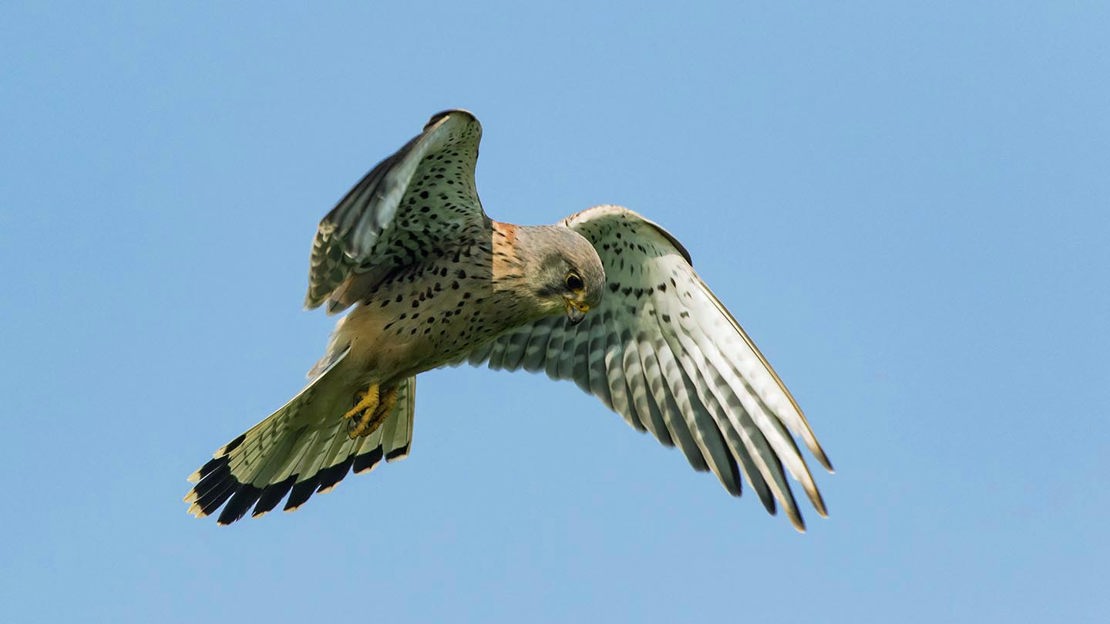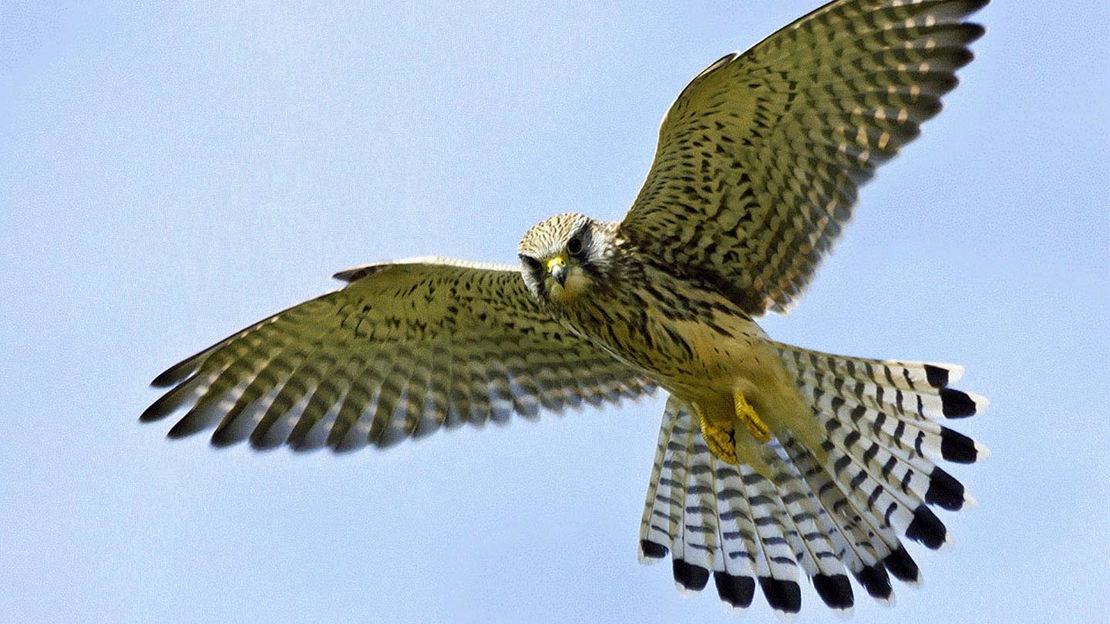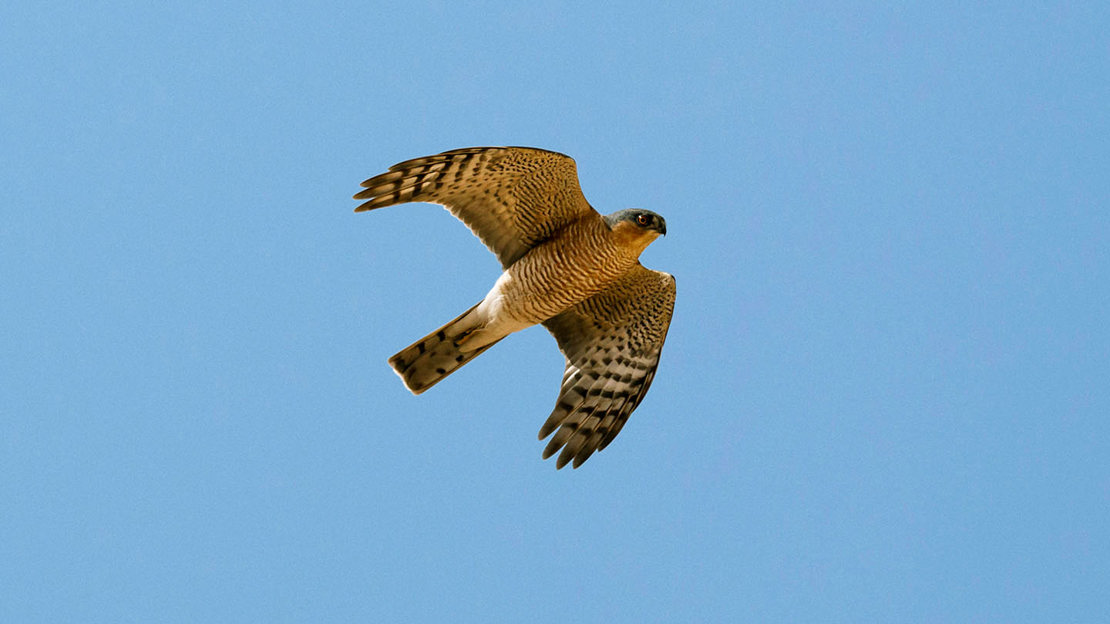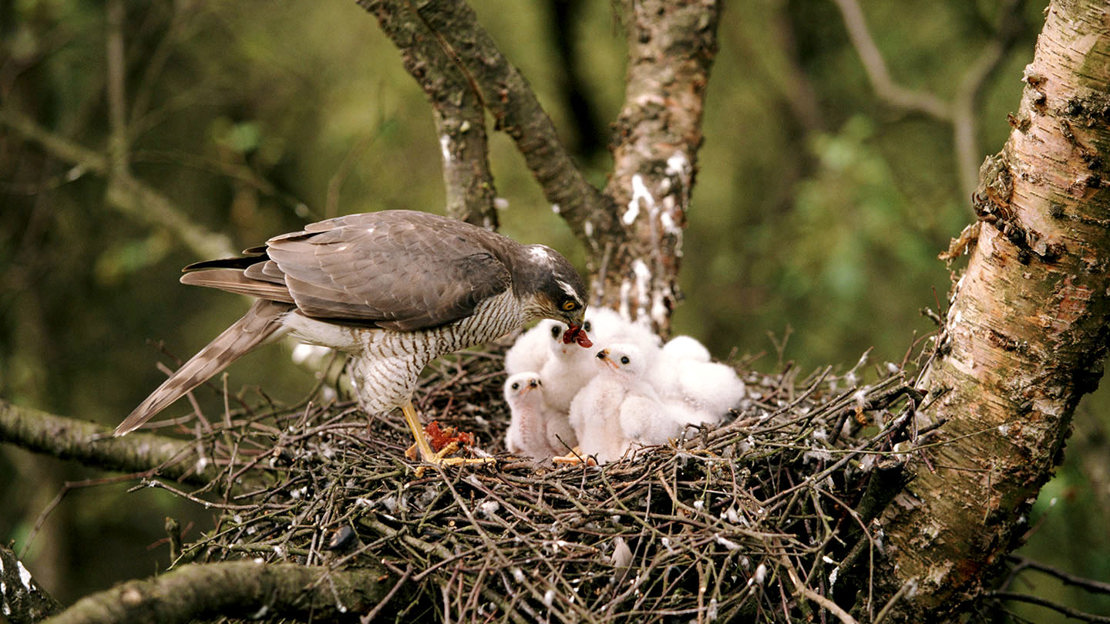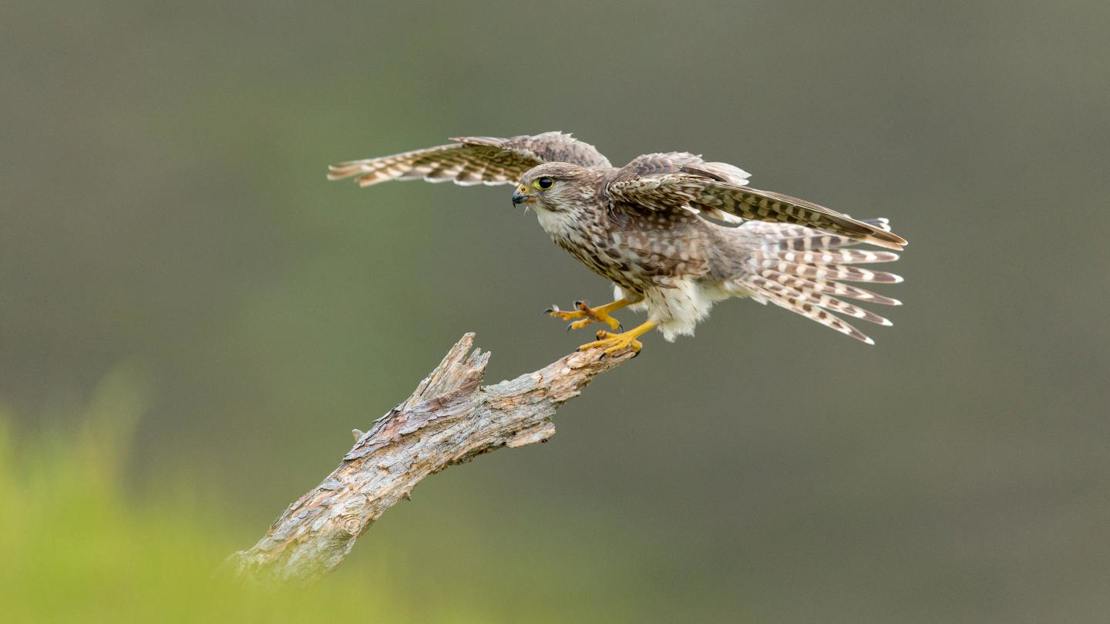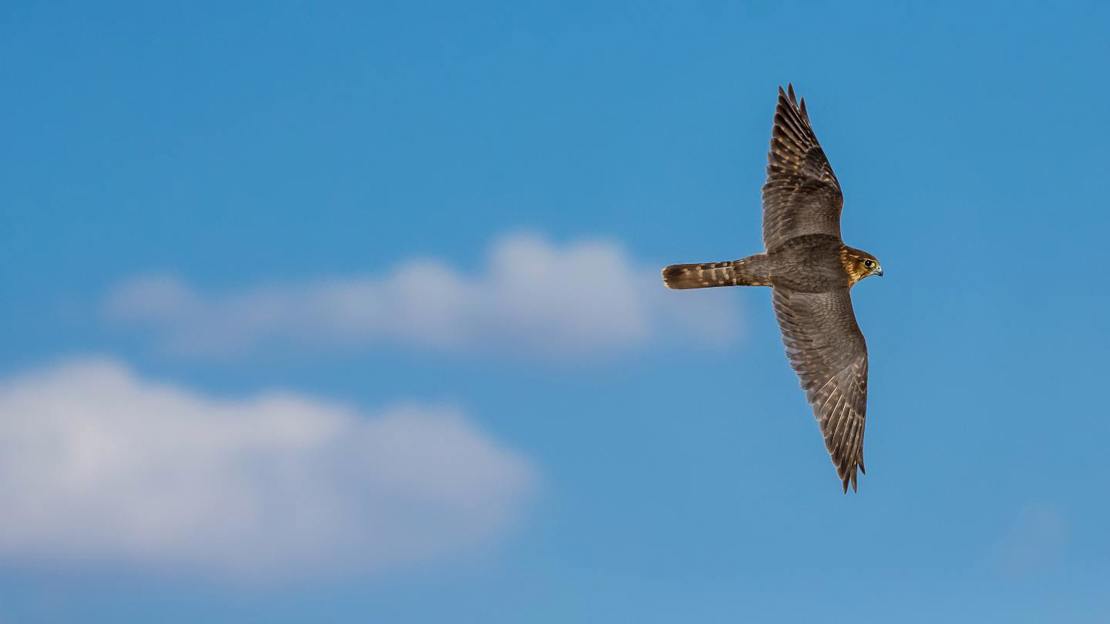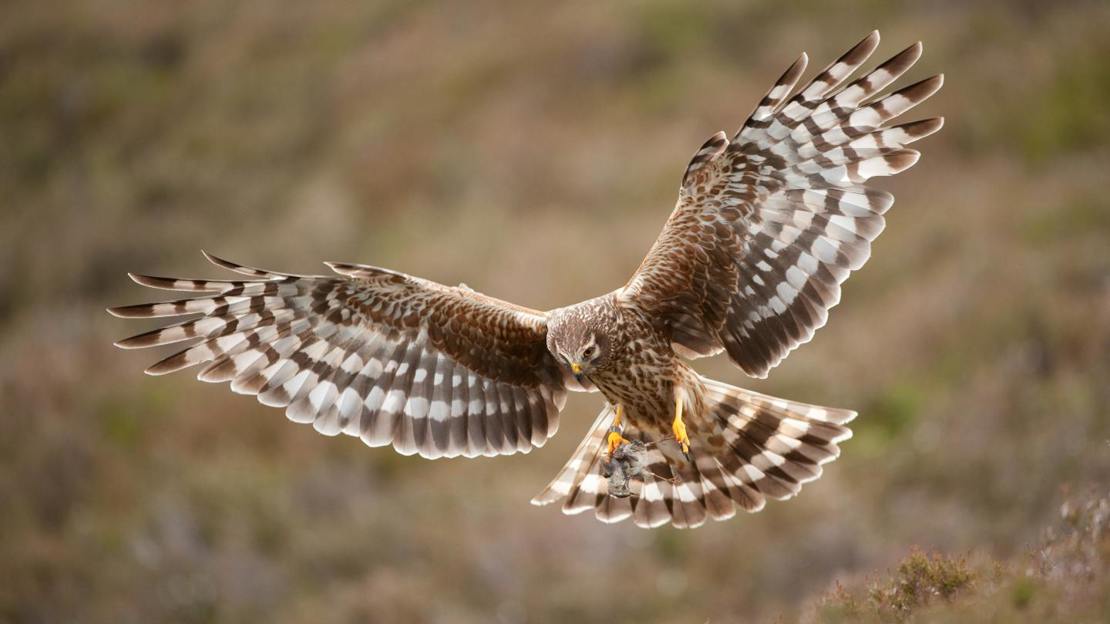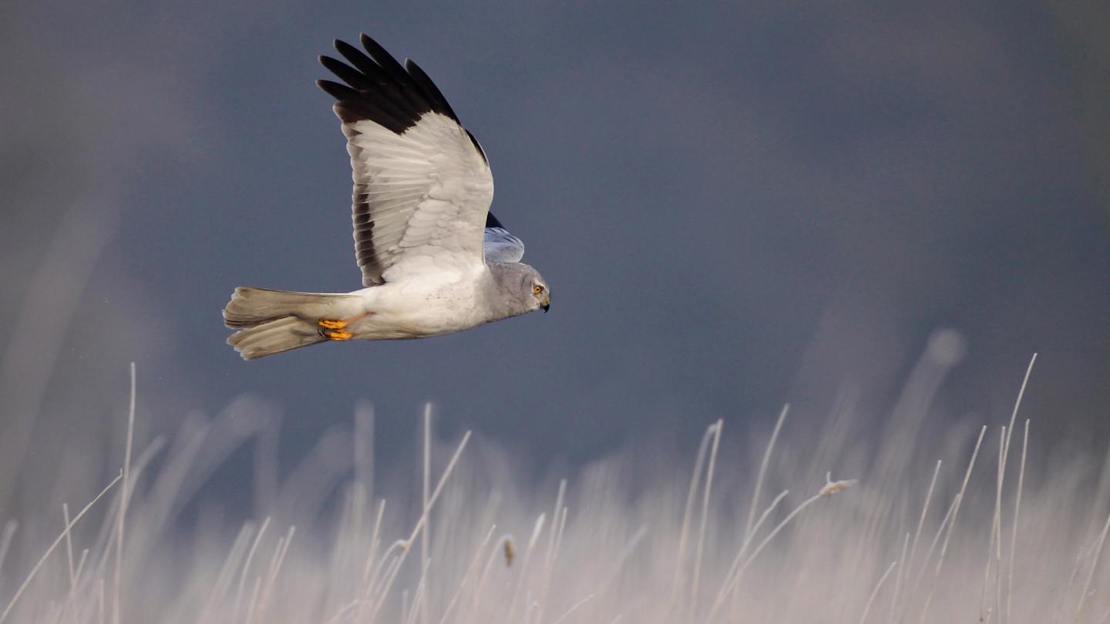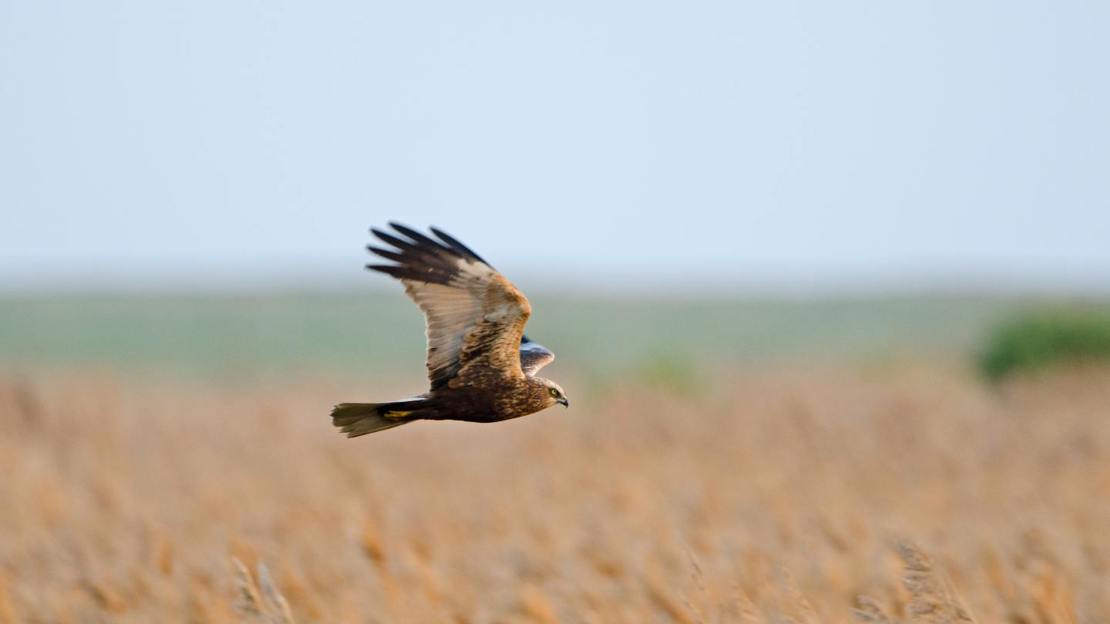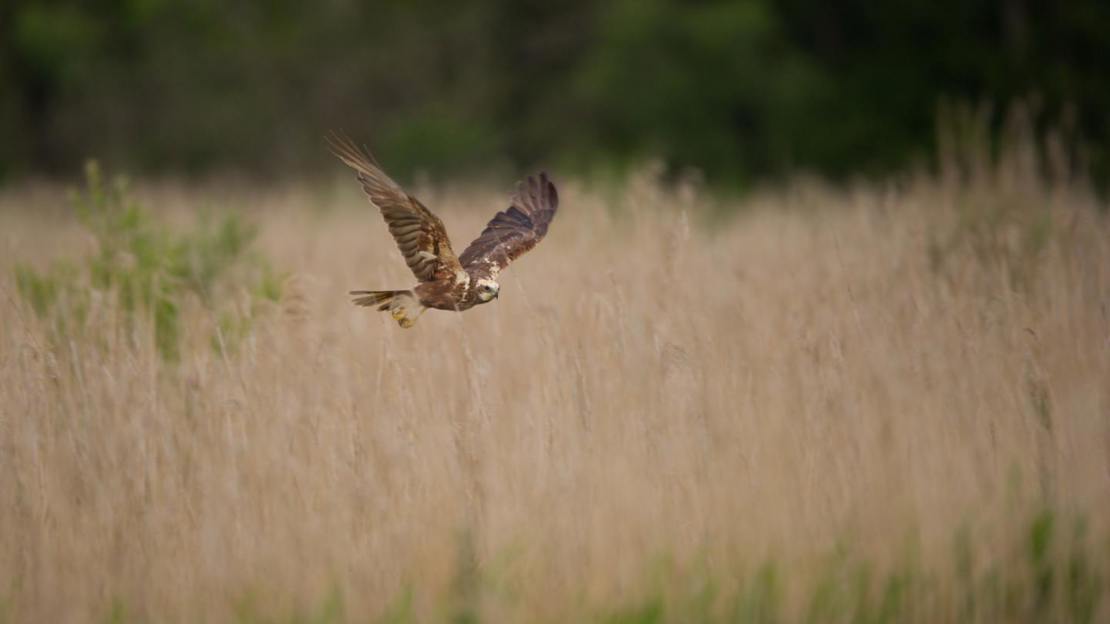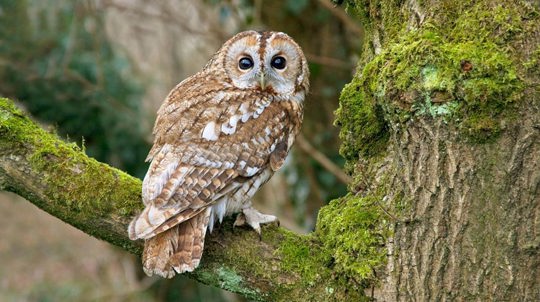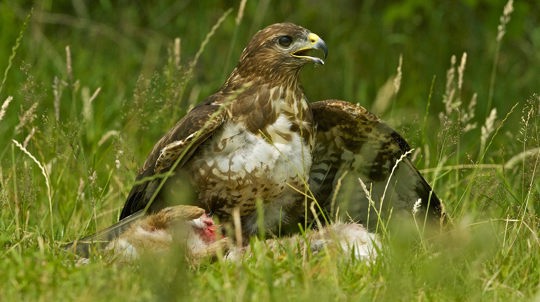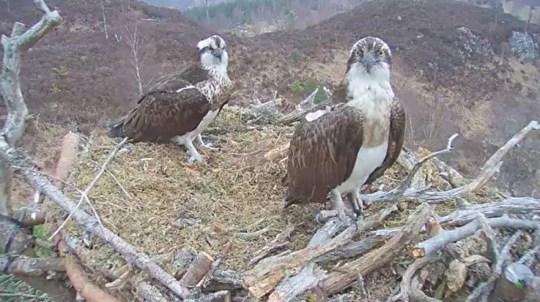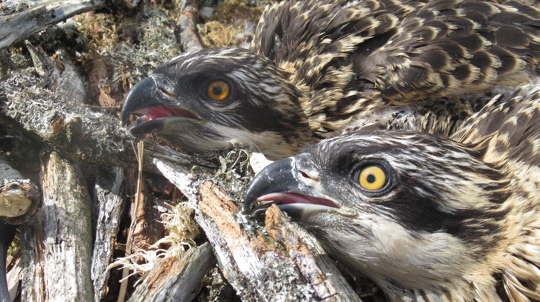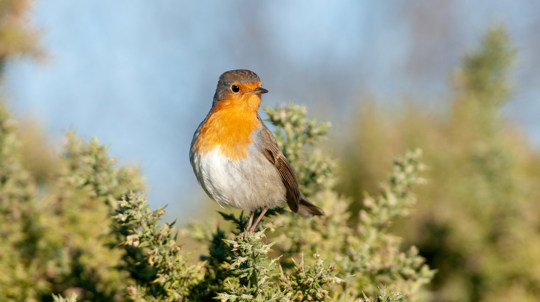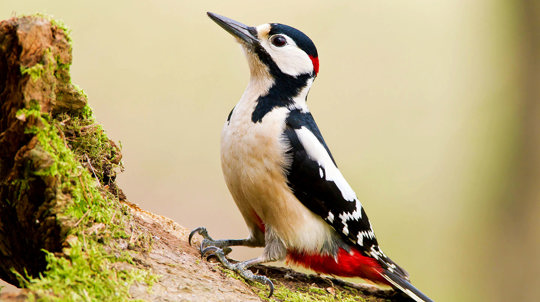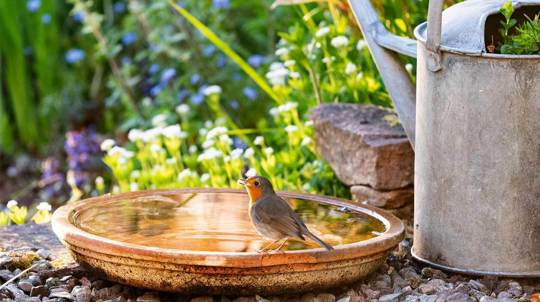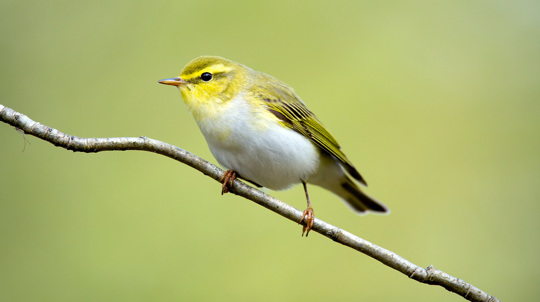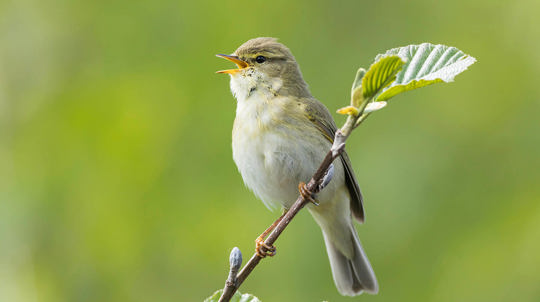In most bird of prey species, the female is larger and heavier than the male. Female goshawks can weigh twice as much as their mates!
Bird of prey calls and identification

Content manager
Learn how to identify 13 of the UK's birds of prey with our quick guide to their calls, key features and likely hangouts.
1. Common buzzard (Buteo buteo)
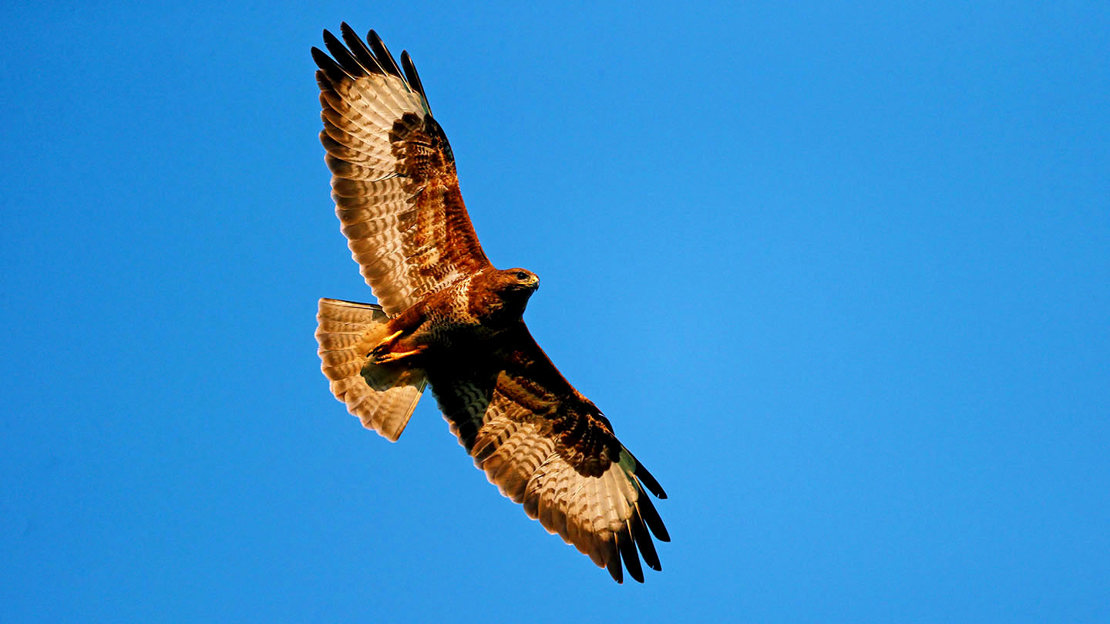
How to identify
The common buzzard has a brown head, back, 'trousers' and top side of the wings. The undersides of the wings are pale in the centre, with darker wing tips and edges. Most also have a pale band across the belly, although this can vary in extent. The legs and base of the beak are yellow.
Not to be confused with the honey buzzard (Pernis apivorus), a rare summer visitor to the UK which usually has paler underparts and grey-brown upperparts.
Size
Wingspan up to 128cm across.
Best time to hear
Listen for the mewling, cat-like call delivered while on the wing in spring and summer.
Where to see them
The UK's most common bird of prey, found almost everywhere. Look for adults soaring on thermals over woodland and open countryside, particularly on sunny days. Also often spotted perched on telephone poles or bare tree branches, and can sometimes be seen scavenging roadkill.
2. Kestrel (Falco tinnunculus)
How to identify
Both male and female kestrels have pale undersides speckled with black and black tips to their fanned tails. On the male the top sides of the wings and back are chestnut brown and the head grey, whereas females are a more muted brown all over. Look also for the pointed wings and dark lines beneath the eyes.
Most readily identified by their characteristic hovering flight while hunting. They are able to hold their head immobile while adjusting their wings and tail to air currents, sometimes beating their wings rapidly to remain in place. This special skill earned them the colloquial name 'windhover'.
Size
Wingspan up to 80cm across.
Best time to hear
Most vocal in summer when communicating with mates and young around their nest site. Listen for a shrill, urgent-sounding 'kee-kee-kee' call.
Where to see them
Widespread across the UK. Look for their distinctive hover as they hunt over scrubby or grassy areas and road verges. Can also be spotted perched on telephone poles or wires.
3. Goshawk (Accipiter gentilis)
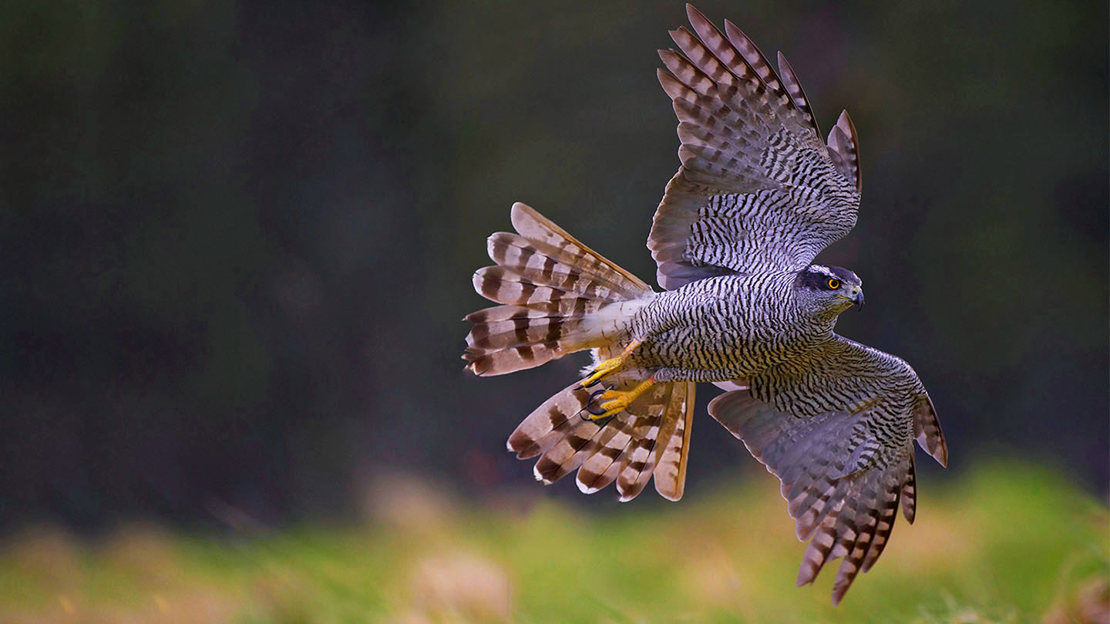
How to identify
The goshawk is said to have a 'fierce' expression, perhaps thanks to the distinctive pale eyebrow and piercing orange-red eyes. The head, back and top sides of the wings are grey. The undersides are pale and finely barred. Look also for the prominent white feathers around the base of the tail.
Not to be confused with the much smaller and more common sparrowhawk (below).
Size
Wingspan up to 165cm across.
Best time to hear
Listen for adults calling to one another during the breeding season.
Where to see them
A rare and secretive species that specialises in hunting among the dense trees of forests. These early breeders begin courtship from late winter and are best looked for when flying over woodland to perform their 'sky-dance' display. Found mostly in Wales, parts of Scotland and northern England, but also in small populations in Norfolk and parts of the south of England.
4. Sparrowhawk (Accipiter nisus)
How to identify
Male and female sparrowhawks are easier to tell apart than most other birds of prey. The female is larger than the male with brown wings, head and back. The underside is pale barred with brown and the eyes yellow. The male has grey wings, head and back and the belly has an orangey tint. The eyes can also be orange in older birds.
Size
Wingspan up to 70cm across.
Best time to hear
Most vocal in spring and summer during breeding. Listen for their 'kek-kek-kek' call.
Where to see them
Common and widespread across the UK and most often encountered in gardens. Look for sparrowhawks perched on fences or flashing past as they ambush small birds on bird feeders.
5. Osprey (Pandion haliaetus)
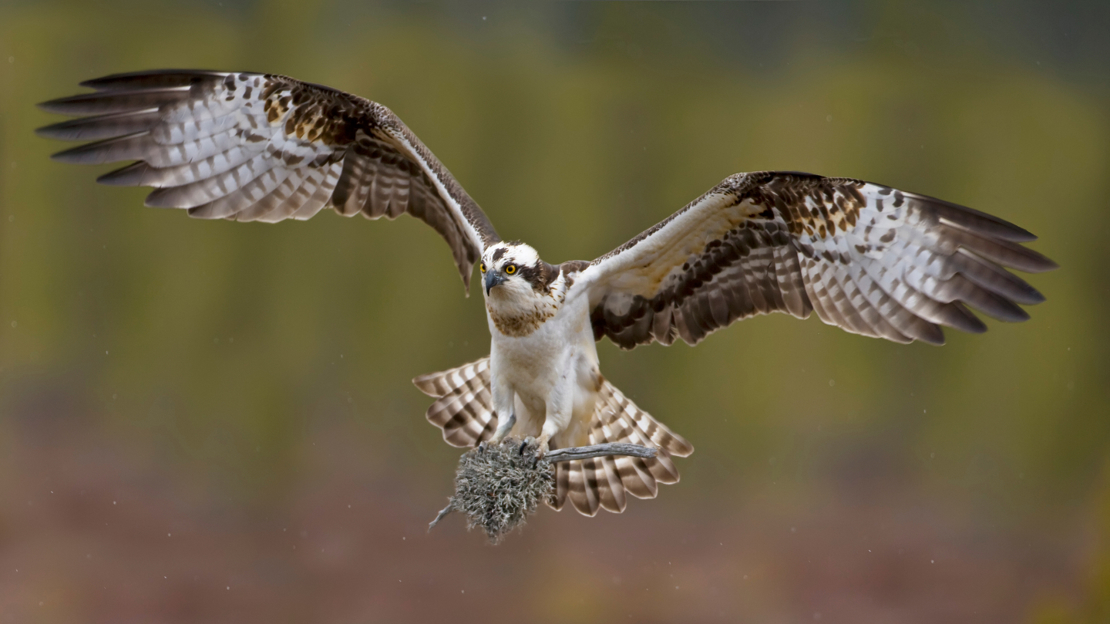
How to identify
The white undersides and long wings make ospreys pretty distinctive when in flight. The upperparts are brown and most have strong brown markings across the eyes and on top of the head. Look also for the mottled brown 'necklace' that can vary in extent.
Size
Wingspan up to 170cm across.
Best time to hear
These birds are summer migrants to the UK, usually arriving from late March and departing for Africa in September. Listen for their courtship calls as males 'sky-dance' over nesting sites in spring.
Where to see them
Breeds by lochs, lakes and estuaries in Scotland, northern Wales, the Lake District and Rutland, but might be spotted by water elsewhere while on migration. Our resident breeding pair at Loch Arkaig Pine Forest can also be viewed during the breeding season on our live osprey cam.
6. Red kite (Milvus milvus)
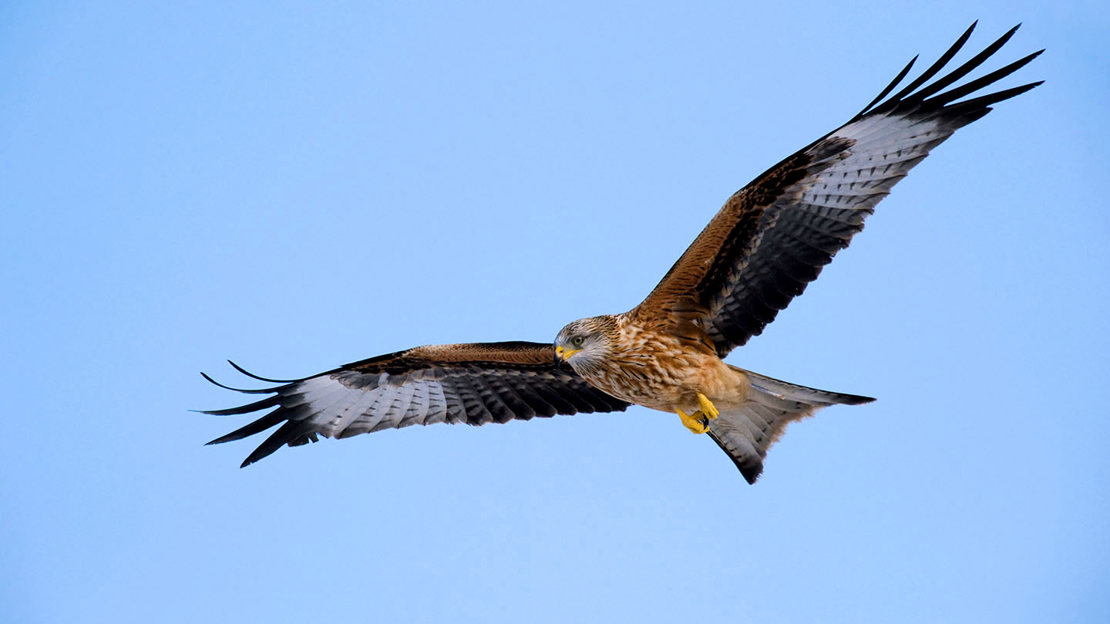
How to identify
The characteristic forked tail and angular wings make the red kite easily recognisable in flight. Look also for the orangey-brown body, leading edge of the wings and upperside of the tail. The undersides of the wings are mostly dark but with white patches towards the ends and the wing tips are black and fingered. The head and underside of the tail are pale.
Size
Wingspan up to 195cm across.
Best time to hear
Listen for their unusual, high pitched 'weoo eoo eoo' display call in spring and throughout the breeding season.
Where to see them
Most common in Wales as well as southern and central England, but expanding in range across other parts of the UK. Can sometimes be spotted gathering in numbers over open countryside and even suburban areas.
Identify woodland birds on the go
Keep our pocket-sized identification guide to hand on your next walk.
Buy yours now7. Peregrine falcon (Falco peregrinus)
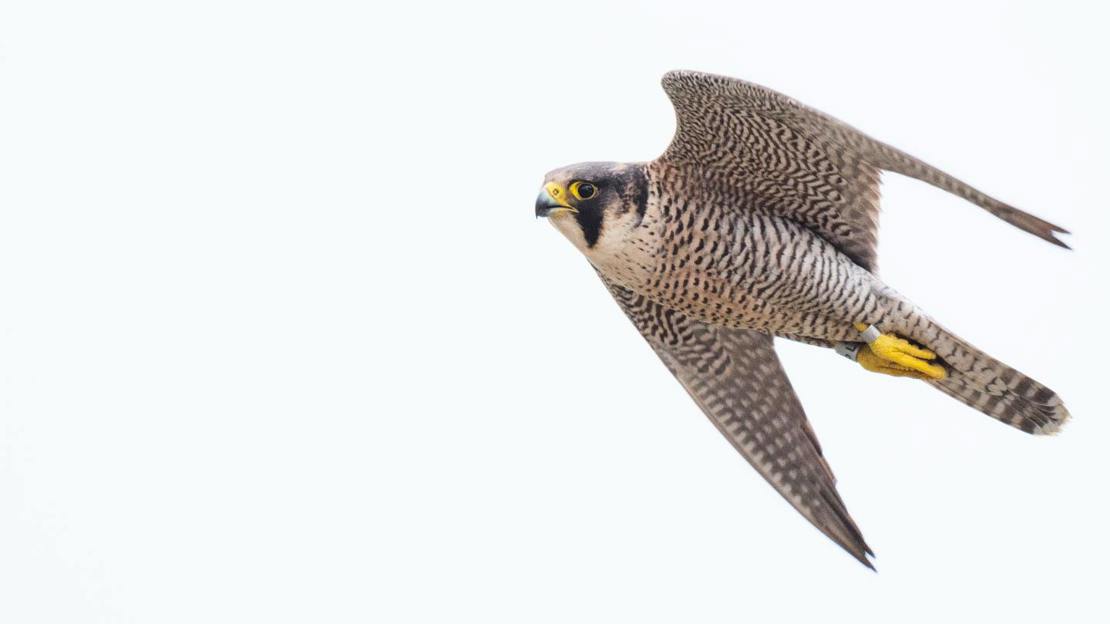
How to identify
The pointed wings and comparatively short tail are the telltale features of a peregrine in flight. The trailing edges of the wings are usually held in a straight line when gliding. Look for fine dark barring on otherwise pale underparts and a dark grey head and upperparts. The strong, dark 'moustache' is also a dead giveaway.
Not to be confused with the much smaller hobby (below).
Size
Wingspan up to 115cm across.
Best time to hear
Peregrines use various vocalisations, including an 'ee-chup' call to announce themselves to other birds, wailing and a 'chi-chi-chi' contact call between mates. Listen out in spring and summer when breeding is in full swing.
Where to see them
These fast, agile hunters are often found in upland habitats or along sea cliffs across the UK, as well as on wetlands and marshes in winter. They're also increasingly breeding in urban areas, particularly where tall buildings offer good nesting sites.
8. Hobby (Falco subbuteo)
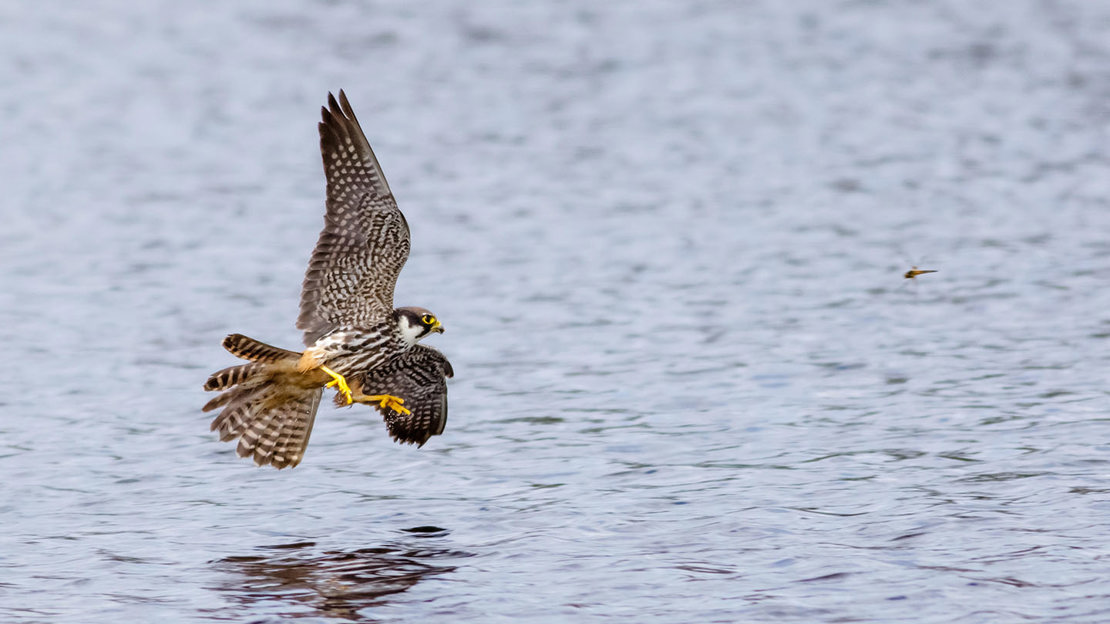
Hobbies will often eat captured prey while still on the wing.
How to identify
Hobbies are similar in size to the kestrel. Look for long, pointed, swept back wings and a slender tail when in flight. The undersides are white streaked with black with orange-red 'trousers' and barred tail. The upperparts and head are black with white cheeks and a black 'moustache'.
Size
Wingspan up to 92cm across.
Best time to hear
Listen for the high-pitched territorial call in May and June around potential nesting sites, such as woodland edges.
Where to see them
A summer migrant to the UK which breeds here from April to October. Look for hobbies hunting for martins, swallows, dragonflies and other large flying insects over wetlands, rivers and heathland across England and Wales.
9. Merlin (Falco columbarius)
The merlin is the UK's smallest bird of prey.
How to identify
Female merlins are mainly brown with a streaked breast and barred tail. Males have slate-grey upperparts and orange hued belly. In flight both can resemble the shape of a peregrine, but their behaviour gives them away. Look for rapid wing beats and a low, sometimes bobbing hunting flight.
Not to be confused with the more common and widespread sparrowhawk (above).
Size
Wingspan up to 62cm across.
Best time to hear
Listen for the merlin's chattering courtship call during the breeding season from late April.
Where to see them
Breeds mostly in upland habitats throughout the UK as well as the Scottish Islands, but in winter the UK population is joined by migrants from Iceland and birds move into lowland and coastal areas to hunt, including wetlands and heathlands.
10. Hen harrier (Circus cyaneus)
How to identify
Hen harriers have owl-like faces; a ring of stiff feathers around the face is thought to help direct sound to the ears, a bit like a satellite dish. Like all harriers they have long wings held in a shallow 'v' when gliding. Males have grey heads and upperparts with black wing tips and paler undersides. Females and juveniles, known as ringtails, are barred brown with white rumps.
Not to be confused with Montagu's harrier (Circus pygargus), a very rare summer migrant to the UK.
Size
Wingspan up to 120cm across.
Best time to hear
Listen for the rapid 'chuk-uk-uk-uk' courtship calls during the male's 'sky-dance' display from late March.
Where to see them
A scarce breeder in upland areas of Scotland, Wales, northern England and Northern Ireland, as well as the Scottish Islands and Isle of Man. Can however be encountered in lowland and coastal habitats across the UK in winter.
11. Marsh harrier (Circus aeruginosus)
There are fewer breeding pairs of marsh harrier in the UK than golden eagles.
How to identify
Marsh harriers are larger than hen harriers (above) but fly with the same 'v' shaped silhouette. The top side of the wings on males are grey with black wing tips and brown leading edge and body. Wings are pale beneath as is the tail and head. Females are mainly brown with a characteristic golden crown and cheeks.
Size
Wingspan up to 130cm across.
Best time to hear
Most vocal during the breeding season. Listen for the male's nasal display call in spring or for the female's piping whistle when receiving food from her mate.
Where to see them
A rare breeder found mainly in parts of eastern and north-west England. As the name suggests, wetlands and reedbeds are its preferred habitat, although it can sometimes be spotted over farmland. Can occasionally be seen in some numbers, particularly in winter when they gather together into roosts.
12. Golden eagle (Aquila chrysaetos)
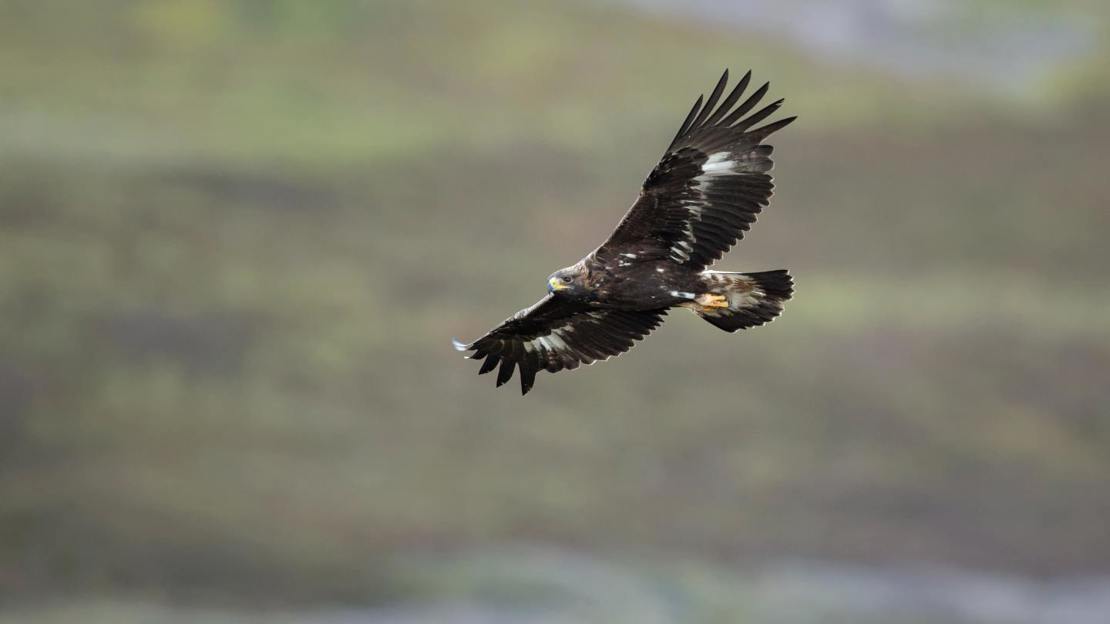
How to identify
The long, broad wings and pronounced fingers at the wing tips should help distinguish the golden eagle's silhouette from the buzzard when in flight. The tail is longer than that of white-tailed eagles (below) and fan-shaped. Adults are typically dark brown with a more golden tint to the head and nape.
Size
Wingspan up to 220cm across.
Best time to hear
Golden eagles are less vocal than some of the other birds on our list and rarely heard. You might be lucky to hear the adult's high, thin call while in flight.
Where to see them
Found in the Highlands and Islands of Scotland as well as parts of Northern Ireland. Look for soaring birds hunting along mountainsides or displaying in winter and early spring.
13. White-tailed eagle (Haliaeetus albicilla)
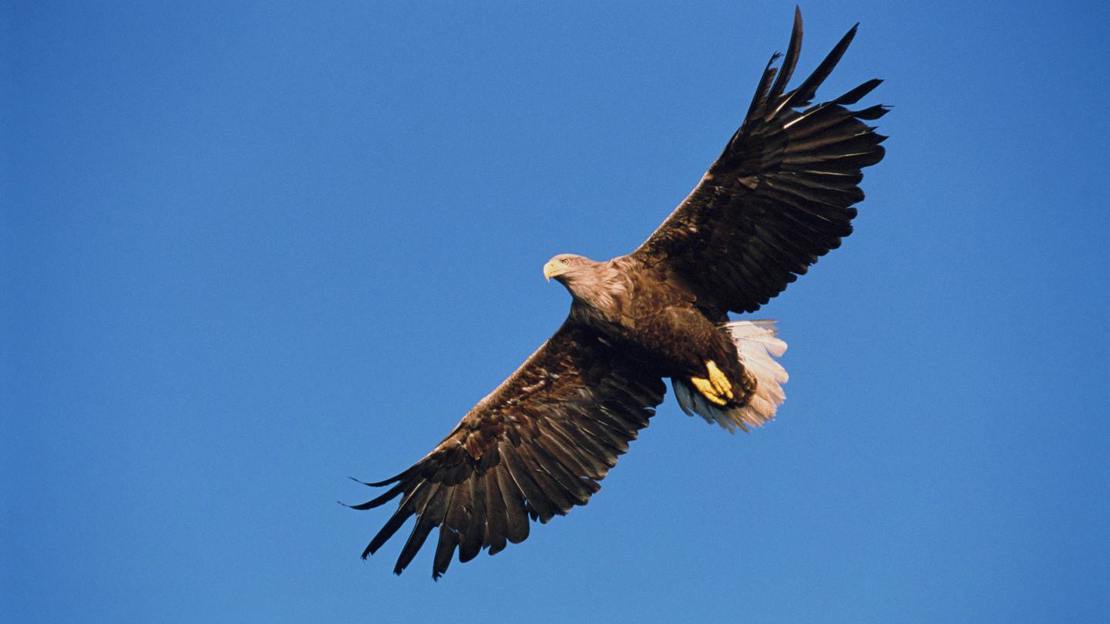
How to identify
White-tailed eagles are the largest bird of prey in the UK and should be difficult to mistake for anything else. In flight their broad, blunt wings give them an almost rectangular shape, with defined fingers at the tips. Also look for a short, wedge-shaped tail which, as the name suggests, is white in adults. The head is also pale.
Size
Wingspan up to 240cm across.
Best time to hear
Usually only heard when nesting, producing an almost yapping, woodpecker-like call.
Where to see them
Most likely to be encountered along the west coast of Scotland and the Scottish Islands, although they have also recently been reintroduced to the Isle of Wight.
Discover more about the UK's birds
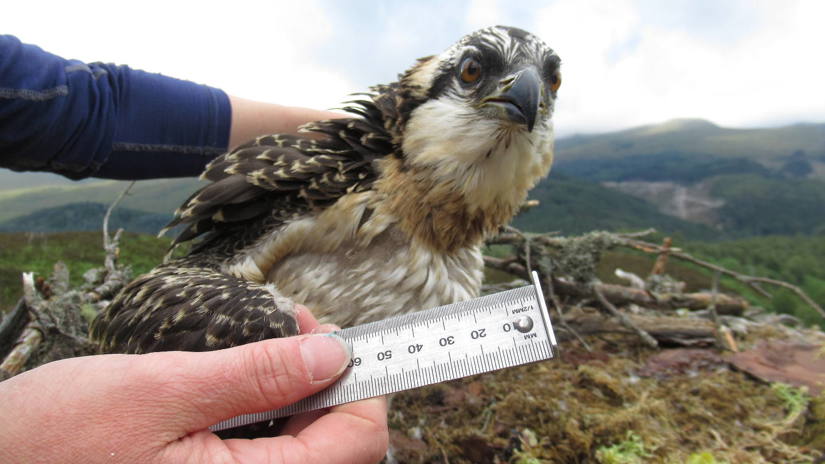
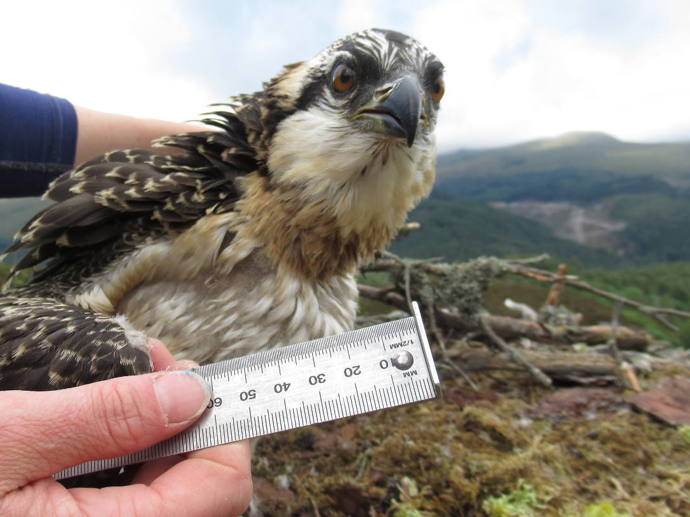
Loch Arkaig osprey cam
Follow the story of our Loch Arkaig ospreys, live from the heart of an ancient Caledonian pine forest.


